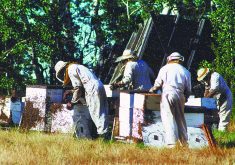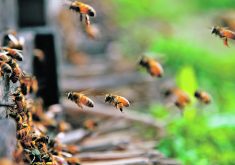Three-year pilot project will include bear damage to beehives as part of the Wildlife Damage Compensation program
The idea of bears diving into beehives to get at honey may conjure comical images of Winnie the Pooh or Yogi Bear, but it’s serious for beekeepers, who could face substantial damage costs.
Now, Alberta’s Agriculture Financial Services Corp. is launching a three-year pilot to include bear damage to beehives as part of the provincial Wildlife Damage Compensation program.
Damages incurred between May and the end of October will be covered under the program for beekeepers with a minimum of 100 hives, with claims covering 80 percent of losses for lost colonies, hive replacement and loss of honey.
Read Also

U.S. bill could keep out Canadian truckers
The Protecting America’s Roads Act, which was tabled in the U.S. House of Representatives at the beginning of October, would “rid the country of illegal immigrant commercial truck drivers and ineligible foreign nationals.”
Connie Phillips, executive director of the Alberta Beekeepers Commission, welcomed the move.
“A couple of years ago, we did a survey with our beekeepers to get an idea of what was going on with bear depredation because that’s when we started the conversation with AFSC, Alberta Environment and Alberta Agriculture,” said Phillips.
That survey revealed Alberta’s Peace Country was the centre of bears getting into hives with more than 1,000 incidents reported in 2020.
Other areas faced fewer incidents, numbering in the dozens, mostly in areas bordering the Rockies and around Edmonton.
Most respondents to the survey already used fencing, said Phillips, but bears will often continue to find ways to get through it.
She added the costs of such incidents for those outside the industry haven’t always been well understood.
“The bear totally destroys the box and the bees fly away or they don’t quite destroy the box but disturb bees so that the queen will leave. Either way, they still take the honey, so there is a combination of losses,” said Phillips.
“I think what AFSC has rolled out touches on all of that nicely. It’s not quite what it costs — it never is. But they cover costs for bees that get lost, they cover some of the costs of replacing the damaged boxes and frames and they also cover the cost of some of the lost honey — which is good.”
Identifying bears as the culprits for the damage is easier than it was a few years ago because many honey producers have cameras that record the interaction. It may be more difficult to identify the cause of damage to hives placed in fields.
“But I think it’s pretty clear when a bear has come in and smashed the hive around versus when the colonies are out on grazing land… and cattle rub up against (hives) and knock them over.”
Phillips plans to monitor whether fires in the northwestern part of the province will result in more damage from bears that are displaced from their usual area and see hives as easy food sources.
The association’s survey also revealed the determination of bears to get to honey. They have knocked down or short-circuited electrified fences and dug beneath them to reach hives.
Damage most often occurs in the spring and late summer, according to the survey.
Those making a claim to AFSC are required to do so within 48 hours of the damage being discovered.
Beekeepers must gather photographic evidence and damaged components can’t be cleaned up until an adjuster releases the claim.
More information on the program can be found through the AFSC or Alberta Beekeepers Association websites.


















